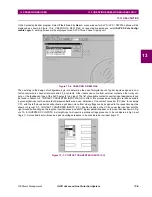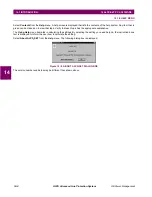
13-2
ALPS Advanced Line Protection System
GE Power Management
13.1 INTRODUCTION
13 XPRESSION BUILDER
13
13.1.4 BOOLEAN OPERATORS, LATCHES, TIMERS, & COUNTERS
a) BOOLEAN OPERATORS
The operation of the Boolean operators (AND, OR, and NOT) are self explanatory. Each gate may have up to four (4)
inputs. Each of the inputs may be logically inverted by clicking the right mouse button when the cursor is at the input of the
gate. A small circle at the gate input will indicate the inversion of the input signal. The output can also be inverted by click-
ing the right mouse button when the cursor is at the output of the gate. A small circle at the gate output will indicate the
inversion of the output signal.
b) LATCHES
A “D” flip-flop is used in the Xpression Builder logic as shown in Figure 13–2: LATCH AND TRUTH TABLE. The D input is
where the data bit to be stored is applied. The T or clock input controls the flip-flop. It determines whether the data on the D
input line is recognized (clocked) or ignored. If the T input line is high (binary 1), the data on the D input line is stored in the
flip-flop. If the T input line is low (binary 0), the D input line is not recognized. The Q output line directly reflects the state of
the flip-flop. If the flip-flop is set, then Q equals a high (binary 1). If Q equals a low (binary 0), then the flip-flop is reset.
Figure 13–2: LATCH AND TRUTH TABLE
c) TIMERS
There are two types of timers used in the Xpression Builder: the Pickup/Dropout Timer and the Pickup Relay Timer.
The simplest type is the Pickup/Dropout timer shown in the figure below. The PU = 300 indicates the pickup delay in milli-
seconds and DO = 250 indicates the dropout delay in milliseconds. In both parts A and B, the IN/OUT time charts describe
how the timer functions. If the input is high (binary 1) for a time equal to the pickup delay, the output becomes high (binary
1). Any reset of the input (high to low) causes the accumulated pickup time to reset immediately to zero. Once the output
occurs, it remains high as long as the input remains high, and when the input subsequently goes low the output stays high
for a time equal to the dropout delay. Once the dropout timer has started, it will continue to time out even if the input goes
high during the reset time. Time chart A shows a second input pulse occurring after the output goes low. Since this pulse
length is less than the 300 ms pickup delay, the output stays low. Time chart B shows a second input pulse occurring 100
ms after the first input pulse goes low. The output goes low as shown in time chart B, but the output then goes high 300 ms
after the leading edge of the second input pulse or 150 ms after the trailing edge of the first output pulse. The pickup and
dropout timers are independent of each other.
Figure 13–3: PICKUP/DROPOUT TIMER
D
T
Q
T
D
Q
L
X
Q
0
H
L
L
H
H
H
3 0 0
2 5 0
I N
O U T
P U
D O
P U
D O
P U
P U = 3 0 0
D O = 2 5 0
(A)
(B)
IN
IN
OUT
OUT
















































